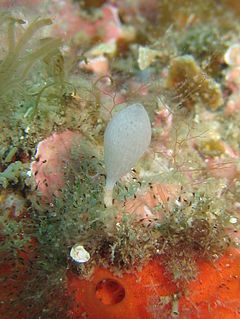
Geodia is a genus of sea sponge belonging to the family Geodiidae. It is the type genus of its taxonomic family.

Polymastia is a genus of sea sponges containing about 30 species. These are small to large encrusting or dome-shaped sponges with a smooth surface having many teat-shaped projections (papillae). In areas of strong wave action, this genus does not grow the teat structures, but instead grows in a corrugated form.

Doriprismatica sedna is a species of colorful sea slug, a dorid nudibranch, a marine gastropod mollusk in the family Chromodorididae.

Felimare orsinii is a species of colourful sea slug, a dorid nudibranch in the family Chromodorididae.
Clathrina jorunnae is a species of calcareous sponge from Norway. The species is named after Jorunn Berg, Hans Rapp's grandmother, who introduced Rapp to marine animals.

Clathrina lacunosa is a species of calcareous sponge from the British Isles. The species name means "having holes" and refers to the perforations found in the sides of the sponge. It is usually found on vertical solid surfaces at depths down to 220 m. It is distributed in the north-eastern Atlantic from the Arctic to the Mediterranean. It is a fairly common sponge but is often overlooked due to its small size.

Felimare tricolor is a colourful species of sea slug or dorid nudibranch, a marine gastropod mollusc in the family Chromodorididae.

Felimare cantabrica is a species of colourful sea slug or dorid nudibranch, a marine gastropod mollusc in the family Chromodorididae.

Felimare zebra, common name the zebra doris, is a colourful species of sea slug or dorid nudibranch, a marine gastropod mollusc in the family Chromodorididae.
Nephropsis atlantica, sometimes called the scarlet lobsterette or scarlet clawed lobster, is a species of lobster from the Atlantic Ocean.

Codium fragile, known commonly as green sea fingers, dead man's fingers, felty fingers, forked felt-alga, stag seaweed, sponge seaweed, green sponge, green fleece, and oyster thief, is a species of seaweed in the family Codiaceae. It originates in the Pacific Ocean near Japan and has become an invasive species on the coasts of the Northern Atlantic Ocean.
Geodia exigua is a species of sponge that produces the sesquiterpene spiro compound exiguamide. The species was first described by Johannes Thiele in 1898. It is a marine organism known from Japan.

Muggiaea atlantica is a species of small hydrozoan, a siphonophore in the family Diphyidae. It is a cosmopolitan species occurring in inshore waters of many of the world's oceans, and it has colonised new areas such as the North Sea and the Adriatic Sea. It is subject to large population swings, and has been held responsible for the death of farmed salmon in Norway. The species was first described by J.T. Cunningham in 1892 from a specimen obtained at Plymouth, England.

Geodia barretti is a massive deep-sea sponge species found in the boreal waters of the North Atlantic Ocean, and is fairly common on the coasts of Norway and Sweden. It is a dominant species in boreal sponge grounds. Supported by morphology and molecular data, this species is classified in the family Geodiidae.

Geodia megastrella is a species of sponge in the family Geodiidae. It is found in the waters of the North Atlantic Ocean. The species was first described by Henry John Carter in 1876.
Geodia macandrewii is a species of sponge in the family Geodiidae. It is found in the waters of the North Atlantic Ocean. The species was first described by James Scott Bowerbank in 1858.
Geodia hentscheli is a species of sponge in the family Geodiidae. It is found in the waters of the North Atlantic Ocean. The species was described in 2010 by Paco Cárdenas, Hans Tore Rapp, Christoffer Schander & Ole S. Tendal.
Geodia arabica is a species of sponge in the family Geodiidae. It is found in the waters of the Arabian Sea and of the Red Sea. The species was first described by Henry John Carter in 1869.
Geodia areolata is a species of sponge in the family Geodiidae. It is found in the waters of the Gulf of Mannar, between the southeastern tip of India and the west coast of Sri Lanka. The species was first described by Henry John Carter in 1880.











